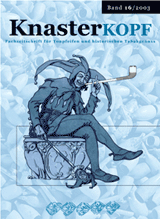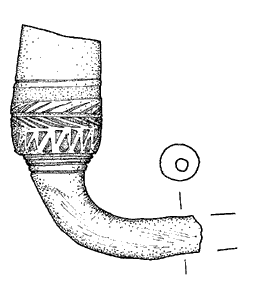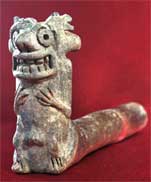 |
|
No. 16 / 2003 The main topic of this volume is |
 |
| No. 16/2003, p. 11-68 Andreas Heege: Clay pipes from Einbeck, Lower Saxony By 1285 fragments from 30 places of discovery above
all 225 pipe bowls and/or bowl fragments are valuable, from which
100 carry readable marks. The typologies for pipe bowls and stem ornaments,
developed for the Netherlands, can be confirmed by dating adjacent
findings. In Einbeck however a type of pipe with small heel is numerously
represented. It is still to be clarified whether this type is only
a regional peculiarity from the first half of the 18th century or
whether a separate type can be defined, which stands between the basis
types 2 and 3. |
|
|||
|
Beside numerous Netherlands, predominantly probably
Gouda products, a larger number of pipes of manufacturers from the
neighbouring Hildesheim and Hardegsen are present starting from 1740.
Pipes from the period around 1750 also show a large variety of circularly
attached stamps and diagonally fluted stems.
Clay pipes from Uslar inundate the Einbecker market after 1769. For other pipe manufacturers from Hameln, Hannoversch Münden, Grossalmerode and the Westerwald only a small outlet remains open. Due to the Einbecker finds, for the first time the names of Uslarer pipemakers can be linked with certain "horsemarks". The Uslarer production seems also in late 18th and early 19th century to have dominated the Einbecker market. Two round bottom pipes from the second half of the 18th century are decorated with coats of arms and watchwords of Hannoversch and Braunschweig. Also products of the only short term Casselmann production from Hannoversch-Münden are attested. Although multicolored glazed clay pipes from the 17th and early 18th century from surrounding places are well known, there is nothing of the kind in Einbeck. It becomes clear from the Einbecker finds that the typical Netherlands relief pipes of the 18th century obviously do not reach the Einbecker market. It remains also unclear why e.g. pipes from the Braunschweiger area and/or the east and south Harz did not reach Einbeck either. Clay pipes were purchased and smoked for the last time for nostalgic reasons on the occasion of the neighbourhood celebration of 1936. |
|||
| No. 16/2003, p. 69-87 Michael Schmaedecke: Floral decor pipes with mentions of manufacturers found in the southern upper Rhine A classification of clay pipes, discussed among experts already for a long time, is however not tackled with reference to the small quantity of yet acquired evidences. On the basis of floral décor clay pipes found in the southern upper Rhine, certain types are assigned and designated to individual manufacturers. These designations should make it possible to approach the types of pipes found in the future, and to assign them to already known collections. |
||||
|
The classification understands itself as work suggestion,
which still must be refined by more exact investigation of the original
material. |
 Pipe stem of the "M.Kesselhum 1"type, Mannheim 1681
|
|||
|
Beside the native market some Mannheim/Frankenthaler
pipemakers supplied possibly also different regions, whereby the southern
upper Rhine for some represented an important area of distribution.
On this matter, it must be stated however that it is not certain,
whether this export really took place. We must also consider the possibility
that the founded pipes were brought here by consumers such as travellers
and in particular soldiers, who had supplied themselves in the manufacture
area. |
|||
| No. 16/2003, p. 88-98 Ralf Kluttig-Altmann/Martin Kügler: Things are moving in Saxony - Towards emancipation of German research In the development of the clay pipe research in Germany important progress shows up. The initial dependence on the foreign research yielded straight in the last two to three years to a strong self-sufficiency. The development shows up particularly clearly by the example of Saxony where also as a result of the conference of the German Society for Clay Pipe Research in 2002 many new aspects arose. |
||
 Pipes of the Görlitz type, variations 1 and 2, made in the
Oberlausitz, 2nd half of the 17th century, with annexed stem
|
|
|
|
Clay-pipemaker's shop were in the 17th and the 18th
centuries far more frequent in Saxony than so far accepted. To the
15 places known so far we must add Herrnhut (?), Leipzig, Meißen,
Meuselwitz and we can expect other informations. |
|
| No. 16/2003, p. 99-104 Gerda Standke: Clay pipes - Pipe clay. Towards a geological history of raw material The emergence and spreading of clays are bound to certain geological conditions, which were effective particularly in the Tertiary period. In the Saxonian area, clay arises particularly at the southern edge of the Tertiary formations spreading in relative high situations, where it can be won near the surface partly in pits, partly in mines, or opencast often in connection with other raw materials (brown coal, gravelly sands). Within the clay occurrences certain varieties can occur, which are particularly suitable for the production of clay pipes. Those are predominantly fine, relatively fat and white-burning clays. In the 18th century, the Altstadtwaldenburger pipe makers preferred usually the "pipe clay" from the nearby Frohnsdorf in the Thuringian Principality of Altenburg, but from time to time they bought from the about 40 km removed Grimma area. |
|
|
| No. 16/2003, p. 105-112 Marita Pesenecker: Clay pipes production in Grimma Clay pipes production began in Grimma in the 17th
century. The pipemakers bought from Groß- and Kleinpösig,
where the clay pits were on the lands of the farmers. The clay price
was about 2 Taler and 14 groschens for a tun and the indicated annual
consumption was 2000 hundredweights by the end of the 18th century.
Sporadically, the Waldenburger pipemakers provided themselves with
clay from Pöhsig. |
|
|
|
|
|
|
| No. 16/2003, p. 113-116 Ralf Kluttig-Altmann: Clay pipes in Leipzig - (Provisional) Conclusion of a survey. A very early pipemaker in Leipzig The article marks the (provisional) conclusion of a series over clay pipes discovered in Leipzig into the 1990er years. Of importance for the pipe research in Saxony and in Germany is a recently discovered source, according to which Hans Thielmann is called in the year 1656 as a pipemaker of Leipzig. Thus he is the fourth-oldest well-known pipemaker of Germany. To summarize the total survey, it can be held that many pipes found in Saxony which were identified formerly as Gouda products, reveal themselves as due to Saxon makers. Under this criterion new finds both in Saxony and in Germany and the trade with Goudae pipes are to be regarded more critically than so far. |
|
|
| No. 16/2003, p. 117 Gerhart Mattuschka: Pipemaker's shops in Leisnig In the Saxonian city clay pipes production has been already in 1697 of economic importance, the beginnings however are still unsettled. For 1753 the presence of only one pipemaker is attested. By the end of the 18th century, the production increased. Pipe fragments found in Leisnig show a large similarity with models from the nearby rival pipemaker's places Grimma and Waldenburg. The pipes production probably ended around 1830. |
|
Clay pipes from the Lichtenberggasse, mid-18th century. |
|
| No. 16/2003, p. 118-130 Bernd Standke: About pipemaker's shops in Waldenburg (Altstadt) In Waldenburg (Altstadt), an extensive and also qualitatively
remarkable clay pipes production developed which only stopped at the
end of the 19th century. The well-known pipemakers as well as numerous
pipe finds from this place are introduced in this contribution. In
spite of the difficulties with the Electorate of Saxony (from 1806
Kingdom of Saxony) and the resulting high transit duties, the coat
of arms of the Elector and his motto seem to have been a popular motive
on the bowls. Just like in Grimma one tried here to make the pipes
more attractive and more salespromoting by imitating Gouda models
(rouletted stem, pedestal stamp, bowl decoration). Two stem fragments
identify Waldenburg (Altstadt) as one of the manufacture places of
the so called Zapfenberg-Pfeifen. |
||
|
No. 16/2003, p. 131-136 Boettger, the inventor of the European porcelain dealt also with the production of pipes as from 1706. First he produced pipe bowls in red-brown Boettgersteinzeug. From 1710 to 1712 he ran his own pipesmaker's shop in Meissen, which was led by Johann Mueller, a pipe maker originating from Wesel on the Rhine. Mueller had been active in Magdeburg and Bevern before.
| |
| No. 16/2003, p. 137-142 Gisela Murken: Cultivation of tobacco and tobacco trade in southern Lower Saxony Since the middle of the 17th century until far in the 20th century, cultivation, processing and trade of tobacco represented an indispensable source of income in southern Lower Saxony. Particularly the valley of the Leine around the places Northeim, Noerten-Hardenberg, Bovenden nearby Goettingen and the Eichsfeld are more near regarded under these aspects. In the Eichsberg the cultivation of tobacco is already proven since 1660. Numerous written sources are abundantly attesting, how 300 years long this branch of trade maintained itself in the region. It got over diseases, quarrels, commercial difficulties, tax increases and competition pressure of imported goods, up into the 20th century, when the cultivation of tobacco became unprofitable. |
|
|
| No. 16/2003, p. 143-149 Jorge Kulemeyer: Smoking pipes from the early Pottery of the archaeological discovery site Moralito, Argentina |
||

|
|
|
| No. 16/2003, p. 149-152 Ralf Kluttig-Altmann/Martin Kügler/Henry Toms: International terminology for clay pipe research. Part I: English-German The use of foreign literature is hardly to be gone around when dealing with the strongly interlaced European research. With the translation of special terms difficulties soon do arise. These terms can be either common words, which in the clay pipe research have a special meaning which cannot be found in a usual dictionary. Or special word creations and/or modifications are concerned, which one looks for in vain in most dictionaries. Under these conditions misunderstandings can easily work their way in the translations, which later unnoticed will be continued. For this reason it is very important to arrange lists of the technical terms. The authors start a series, which first takes care of the languages from the countries with a traditionally strong research and therefore a large number of publications. The available first part of the international terminology begins with English: |
|
| New Finds No. 16/2003, p. 153 f. During the rehabilitation of the "St. Juergen
am Strande" monastery at 41, Mönchstraße, in the spring
of 1996, dozens of clay pipe stems came to day. The stems had been
pulled on thin wire and attached matt-like to compensate unevennesses
on the southwest side panel in the first upper floor, directly on
the panes under the baroque plaster from the building time of the
house (1753/54). Over this "levelling layer" one had fastened
another reed matt to stick the whole on. |
|
| No. 16/2003, p. 154-159 Daniel Schulz: Smoking - No Smoking. Pipe-smoker in the Schloss Ludwigsburg, Württemberg In the Ludwigsburger Schloss, during rehabilitation works, graffiti of pipe-smokers were discovered dating from the construction period of the castle, around 1725-35. Pipe-smokers are represented with classical pipes - probably German craftsmen and associates - and pipe-smokers with floral decor pipes - Italian and Croatian craftsmen. On the building site, miscellany cultures melted together: not only top artists coming from Italy, Austria and Boehmen, but also simple craftsmen.
|
|
||||
| No. 16/2003, p. 159-164 Maren Weidner: Clay pipe finds from the Reichenstraße in Hamburg Among the finds a particularly high portion is to be clearly determined as coming from German workshops. For Hamburg, in the second half of the 18th century, the main supply places, beside Altona and Hannoversch Münden, were Wahmbeck, Großalmerode and Uslar. The accumulated occurrence of pipe stems with the names Knecht and Goebel is particularly remarkable. In addition to already frequent observations with finds in northern Germany, it is confirmed that the pipe makers in southern Lower Saxony and northern Hesse copied Gouda marks. The side mark "coat of arms of Gouda" is falsified into a divided coat with deepened point, so that the plagiarisms are well recognizable. |
|
| No. 16/2003, p. 165-170 Wojciech Siwiak: Pipe finds of the 17th and 18th centuries from archeological sites in the area of Bydgoszcz (Bromberg) Those pipes, mainly from the 18th century, were not imported, after their marks to conclude, from the Netherlands. Rather comes predominantly in question the factory of Roscin (Rostin in the Neumark), but supplies from Weißenspring are proved as well by stem inscriptions. The clay pipes and porcelain bowls, among which one from Tettau, attest remote trade of the city at the end of the 18th century.
|
||||
|
No. 16/2003, p. 170-180 The overall view of written sources and the entire archaeological find material show that Iceland came in contact with tobacco approximately in the second decade of the 17th century for the first time. From then on, the tobacco consumption spread very fast by means of clay pipes on the entire island. The necessary implements, tobacco and pipes, came either on legal way by Danish trade partners or illegal way with foreign smugglers to Iceland. Numerous pipe finds make it clear that thereby products of Holland dominate; a large number of pipes came from Denmark but only few pieces could be identified as originated from England, Sweden or Germany.
|
|
|
| No. 16/2003, p. 180-189 Richard Gartley: German short clay pipes from excavations in the USA In an broadly put overview, finds of floral decor bowls from the 19th century imported from Großalmerode and Uslar into the USA were presented. Beside usual motives (philosophers, Hercules, womenheads, Turks), effigies of American politicians and presidents are particularly interesting. They can be exactly dated on few years, since the popularity of the pipes was dependent on the career of the politicians. The previously accepted opinion, such pipes were rather smoked by slaves, must be abandoned. It is proved that such pipes have been produced by American factories, which resided in Ohio, New Hampshire and Virginia. Native production was qualitatively worse, but the manufacturers could use the disturbances of the world trade due to the American civil war for their own benefit. |
|
|
| No. 16/2003, p. 190 f. Martin Kügler: The certificate of Johann Wilhelm Dorn in 1777 For the first time a certificate from Grenzhausen (Westerwald) was discovered, signed by Peter Dorn, upper master of the pipemakers in the county at that time existing of Wied-Neuwied. The new companion, J.W. Dorn was born in 1756, became himself a master in 1781 and died already in 1796. He originated from a poor pipemaker's family and was a distant relative of the upper master. The document is a rare evidence of the life of a simple pipemaker in the 18th century.
|
|
| No. 16/2003, p. 192 Natascha Mehler: A story about the several uses of tobacco Some oral tradition reports that, probably in the beginning of the 20th century, a man treated his haemorroids with tobacco - and was successful. |
|
| No. 16/2003, p. 193 Heinz-Peter Mielke: Notes about the production of clay pipes in Veneto Beside glass pipes, made by glassworkers from Murano, in Veneto, clay pipes were also manufactured: in Chioggia, Bassano del Grappa and in Piazzola sul Brenta. One of these manufactories still exists today in Bassano. However, the production changed over to briar pipes. |
|
Home
KnasterKOPF
Society
Sitemap
Contact us
Impressum
last update: 2013-11-28